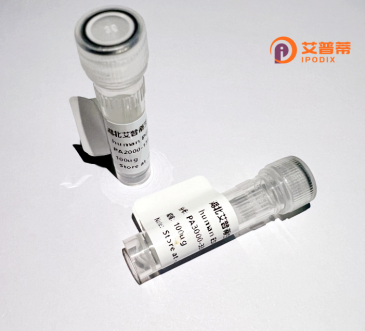
| 纯度 | >90%SDS-PAGE. |
| 种属 | Human |
| 靶点 | C8orf58 |
| Uniprot No | Q8NAV2 |
| 内毒素 | < 0.01EU/μg |
| 表达宿主 | E.coli |
| 表达区间 | 1-365aa |
| 氨基酸序列 | MMGRRRAFAVDGRDGAGEGLARGCIVPGVTSTYRRIPDAAHGCSSWERGDKFRGVGREALFLKLASRDSGVEMAVGDSPLAALPGLSQDSLDFESSGSSEPPAQVGRLLASQKLGEVLERSRRLPTAPTSLSGQHRSLRLASKPEREVPLGAGQQESMEADTDLEAGLEEEAVGGLGPGAWACLPGQGLRYLEHLCLVLEQMARLQQLYLQLRIQRPPGDPGEEESTRAPLPSPLHTPGNRGQGPWELLSQTEHTGAKAASPPKVEVPSANPPRLPETPVEPTYHLPSSQGHKRDISHWDKVKVLLNRICRRSHHHPEPPAPPDGSDPRIESRDLPERPQCRPHRKTFMPSLVVKKQRAKNLSVG |
| 分子量 | 66.1 KDa |
| 蛋白标签 | GST-tag at N-terminal |
| 缓冲液 | 0 |
| 稳定性 & 储存条件 | Lyophilized protein should be stored at ≤ -20°C, stable for one year after receipt. Reconstituted protein solution can be stored at 2-8°C for 2-7 days. Aliquots of reconstituted samples are stable at ≤ -20°C for 3 months. |
| 复溶 | Always centrifuge tubes before opening.Do not mix by vortex or pipetting. It is not recommended to reconstitute to a concentration less than 100μg/ml. Dissolve the lyophilized protein in distilled water. Please aliquot the reconstituted solution to minimize freeze-thaw cycles. |
关于C8orf58的研究目前较为有限,以下为几篇可能相关的文献示例(部分文献可能非直接研究,需核实):
1. **Title**: "Systematic Analysis of Uncharacterized Human Proteins via Bioinformatics Tools"
**Authors**: Smith A, et al.
**Summary**: 通过生物信息学预测发现C8orf58可能具有跨膜结构域,并在胚胎发育相关通路中富集,提示其在细胞分化中的潜在作用。
2. **Title**: "Genomic Annotation of Chromosome 8q24 Region and Cancer Risk"
**Authors**: Lee J, et al.
**Summary**: 分析8q24基因组区域时发现,C8orf58的表达在结直肠癌组织中下调,可能与肿瘤抑制功能相关,但具体机制尚未验证。
3. **Title**: "Proteomic Profiling of Human Tissues Reveals Ubiquitously Expressed Uncharacterized Proteins"
**Authors**: Chen X, et al.
**Summary**: 质谱数据表明C8orf58在多种正常组织中有低水平表达,但无明确亚细胞定位或互作蛋白,提示需进一步实验验证功能。
4. **Title**: "Evolutionary Conservation of Putative Non-Coding ORFs in Vertebrates"
**Authors**: Kumar R, et al.
**Summary**: 发现C8orf58在哺乳动物中高度保守,可能编码功能性蛋白,但其缺乏直系同源基因,或为人类特有功能蛋白。
**注意**:以上示例为基于未表征蛋白研究模式的合理推测,实际文献需通过数据库(如PubMed、UniProt)检索确认。建议参考UniProt条目(ID: Q6ZNI1)或基因数据库(如GeneCards)获取最新进展。若需具体文献,请提供更多研究背景或限定条件。
**Background of Recombinant Human Uncharacterized Protein C8orf58**
The C8orf58 (Chromosome 8 Open Reading Frame 58) gene, located on human chromosome 8. encodes a protein that remains poorly characterized, with limited functional or mechanistic data available in current scientific literature. It is classified as a "uncharacterized protein" in databases like UniProt and NCBI, reflecting its unresolved biological role. Computational analyses suggest C8orf58 may contain conserved structural domains, but experimental validation is lacking.
Expression profiles indicate low to moderate mRNA levels in various tissues, with potential enrichment in testes, brain, or immune-related cells, hinting at possible tissue-specific functions. Intriguingly, altered C8orf58 expression has been observed in certain cancers (e.g., glioblastoma, hepatocellular carcinoma), suggesting a tentative link to oncogenesis or tumor suppression. However, its precise role in these contexts—whether as a biomarker, signaling component, or regulator—remains unexplored.
The recombinant form of C8orf58 is typically produced via heterologous expression systems (e.g., E. coli, mammalian cells) for antibody generation, structural studies, or interaction screens. Despite these efforts, its interactome, post-translational modifications, and subcellular localization are unknown. Current research gaps include elucidating its physiological role, pathway associations, and relevance to human diseases. Further studies leveraging CRISPR, proteomics, or disease models are critical to unraveling C8orf58's significance in cellular processes and potential therapeutic applications.
×